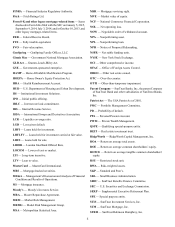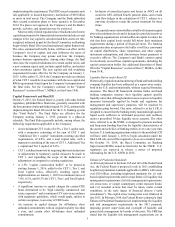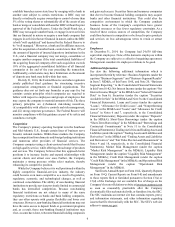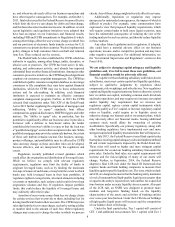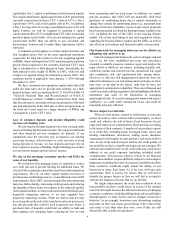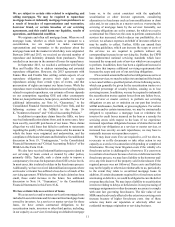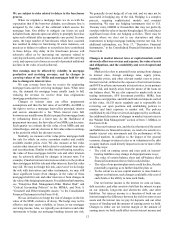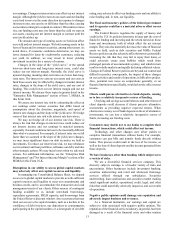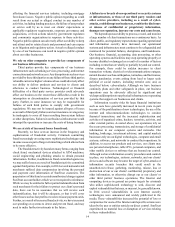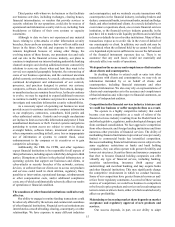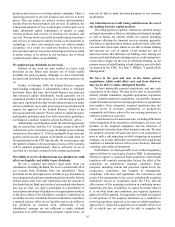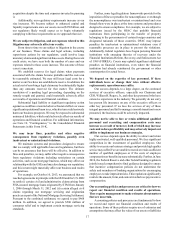SunTrust 2014 Annual Report Download - page 31
Download and view the complete annual report
Please find page 31 of the 2014 SunTrust annual report below. You can navigate through the pages in the report by either clicking on the pages listed below, or by using the keyword search tool below to find specific information within the annual report.8
us, and otherwise adversely affect our business operations and
have other negative consequences. For example, on October 1,
2011, final rules issued by the Federal Reserve became effective
which limit the fees we can charge for debit card interchange,
and this has reduced our noninterest income. In addition, several
recent legislative and regulatory initiatives were adopted that
have had an impact on our businesses and financial results,
including FRB and CFPB amendments to Regulation E which,
among other things, affect the way we may charge overdraft fees
and our provision of electronic funds transfer services for U.S.
consumers to recipients in other countries. We also implemented
policy changes to help customers limit overdraft and returned
item fees. These reduced our fee revenue.
The Dodd-Frank Act also established the CFPB, which has
authority to regulate, among other things, unfair, deceptive, or
abusive acts or practices. The CFPB has been active in rule-
making and enforcement activity, and already has imposed
substantial fines on other financial institutions. Among its other
consumer-protective initiatives, the CFPB has placed significant
emphasis on consumer complaint management. The CFPB has
established a public consumer complaint database to encourage
consumers to file complaints they may have against financial
institutions, which the CFPB may use to focus enforcement
actions and for rule-making. In addition, each financial
institution is expected to maintain an effective consumer
complaint management program. Further, in 2013 the CFPB
released final regulations under Title XIV of the Dodd-Frank
Act in 2013 further regulating the origination of mortgages and
addressing "ability to repay" standards, loan officer
compensation, appraisal disclosures, HOEPA triggers and other
matters. The "ability to repay" rule, in particular, has the
potential to significantly affect our business since it provides a
borrower with a defense to foreclosure unless the lender
established the borrower's ability to repay or that the loan was
a "qualified mortgage" or met other exceptions to the rule. While
qualified mortgages may provide certain safe harbors, the extent
of these safe harbors remains unclear. Our business strategy,
product offerings, and profitability may be affected by CFPB
rules and may change as these and other rules are developed,
become effective, and are interpreted by the regulators and
courts.
Regulators recently published revised guidance which
could affect the origination and distribution of leveraged loans.
While we believe we comply with relevant regulatory
requirements, regulators may limit the ability of banks to
originate leveraged loans, such as by limiting the maximum
leverage of issuers of such loans, or may limit the extent to which
banks may hold leveraged loans in their loan portfolios. If
regulators tighten leverage limits, structural elements including
covenants or maturities, such actions could result in lower loan
origination volumes and fees. If regulators impose portfolio
limits, this could reduce the liquidity of leveraged loans, and
may indirectly affect their value.
A portion of our revenue comes from fees we charge clients
for certain services that we provide to them, including fees for
having insufficient funds in their accounts. The CFPB may issue
rules that limit the fees we may charge, such as by setting a dollar
or number limit to the amount of such fees. Other regulatory
changes may cause us to change the order in which we process
checks. Any of these changes might adversely affect fee revenue.
Additionally, legislation or regulation may impose
unexpected or unintended consequences, the impact of which is
difficult to predict. For example, some commentators have
expressed a view that proposed liquidity requirements, which
will require certain banks to hold more liquid securities, may
have the unintended consequence of reducing the size of the
trading markets for such securities, and thereby reduce liquidity
in those markets.
Any other future legislation and/or regulation, if adopted,
also could have a material adverse effect on our business
operations, income, and/or competitive position and may have
other negative consequences. For additional information, see
the “Government Supervision and Regulation” section in this
Form 10-K.
We are subject to changing capital adequacy and liquidity
guidelines and, if we fail to meet these new guidelines, our
financial condition would be adversely affected.
We, together with our banking subsidiary and broker-dealer
subsidiaries, must meet certain capital and liquidity guidelines,
subject to qualitative judgments by regulators about
components, risk weightings, and other factors. New regulatory
capital and liquidity requirements may limit or otherwise restrict
how we utilize our capital, including common stock dividends
and stock repurchases, and may require us to increase our capital
and/or liquidity. Any requirement that we increase our
regulatory capital, replace certain capital instruments which
presently qualify as Tier 1 capital, or increase regulatory capital
ratios or liquidity, could require us to liquidate assets or
otherwise change our business and/or investment plans, which
may adversely affect our financial results. Issuing additional
common stock would dilute the ownership of existing
stockholders. Specifically, our primary regulatory, along with
other banking regulators, have implemented new and more
stringent capital and liquidity measurements that will impact us.
In July 2013, the Federal Reserve issued final capital rules
that replace existing capital adequacy rules and implement Basel
III and certain requirements imposed by the Dodd-Frank Act.
These rules will result in higher and more stringent capital
requirements for us and our banking subsidiary than under the
prior rules. Under the final rules, our capital requirements will
increase and the risk-weighting of many of our assets will
change. Further, in September, 2014, the Federal Reserve
adopted a final LCR rule under the Basel III framework that
requires banks and bank holding companies to measure their
liquidity against specific liquidity tests. The tests, which include
an LCR, are designed to ensure that the banking entity maintains
a level of unencumbered high-quality liquid assets greater than
or equal to the entity's expected net cash outflow for a specified
time horizon under an acute liquidity stress scenario. Also part
of the LCR rule, an NSFR was designed to promote more
medium and long-term funding based on the liquidity
characteristics of the assets and activities of banking entities
over a one-year time horizon. Under the LCR rule our holdings
of high-quality liquid assets will increase and the composition
of our balance sheet will change.
Under the final capital rules, Tier 1 capital will consist of
CET 1 and additional non-common Tier 1 capital, with Tier 1



